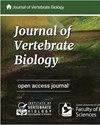Seasonal differences in escape behaviour in the urban hooded crow, Corvus cornix
IF 1.5
4区 生物学
Q2 ZOOLOGY
引用次数: 1
Abstract
Abstract. This study examined escape behaviour of hooded crows, Corvus cornix, in an urban environment, in Belgrade, Serbia, with the goal of assessing the effect of breeding season on components of escape behaviour; flight initiation distance (FID), distance fled (DF), and escape method (flying vs. running/walking). Using GLMMs, it was shown that FID was longer during the breeding season, and increased with alert distance. DF was significantly influenced by escape method, with birds escaping for distances greater than 10 m more often when flying, whereas escape method itself was significantly influenced by FID, with birds escaping more often by flying at greater distances from an approaching predator. The majority of individuals (78%) fled for distances < 10 m after initiating escape, and escaped by walking or running (67%). Our results show that hooded crows, although adapted to living in highly urbanized environments, may be more risk-averse during the breeding season, which may allow them to more successfully take care of their young.城市冠鸦(Corvus cornix)逃跑行为的季节差异
摘要这项研究调查了塞尔维亚贝尔格莱德城市环境中带帽乌鸦Corvus cornix的逃跑行为,目的是评估繁殖季节对逃跑行为组成部分的影响;飞行起始距离(FID)、逃离距离(DF)和逃生方法(飞行与跑步/步行)。使用GLMM,表明FID在繁殖季节较长,并且随着警戒距离的增加而增加。DF受到逃跑方法的显著影响,鸟类在飞行时更经常逃跑超过10米的距离,而逃跑方法本身也受到FID的显著影响。鸟类更经常通过与接近的捕食者相距更远的距离逃跑。大多数人(78%)在开始逃跑后逃离了<10m的距离,并通过步行或跑步逃离(67%)。我们的研究结果表明,戴帽乌鸦虽然适应了高度城市化的环境,但在繁殖季节可能更不愿冒险,这可能会让它们更成功地照顾幼崽。
本文章由计算机程序翻译,如有差异,请以英文原文为准。
求助全文
约1分钟内获得全文
求助全文

 求助内容:
求助内容: 应助结果提醒方式:
应助结果提醒方式:


